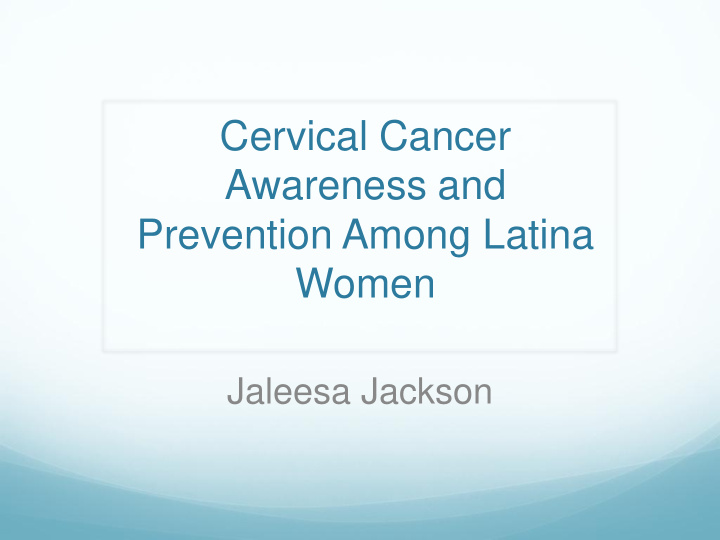



Cervical Cancer Awareness and Prevention Among Latina Women Jaleesa Jackson
Introduction Jaleesa Jackson, soon to be 2 nd year medical student, Johns Hopkins University. Interest in Women’s Health. Clinic Site: 17 th Street Clinic, Santa Ana.
Background Genital HPV is the most common STI. Cause of most cervical cancer cases worldwide. 4 In 2010, 12,200 new cases diagnosed, and 4,210 women died from cervical cancer. 5
Background Los Angeles women are at a higher risk of contracting HPV and developing cervical cancer than the rest of the county. Cervical cancer rate in the Latina population in LA is almost twice the national average. 14.3 per 100K versus 8.1 per 100K. 6
Methods Cervical Cancer Awareness tent. Used the help of promotoras and health educators to assist in educating. 5 question survey in English and Spanish to assess patient knowledge of HPV/Cervical Cancer. 2 raffles: One for completing the survey and one for scheduling a pap smear.
Methods Patients were educated about HPV and cervical cancer by promotoras, health educators, and me. Survey
Results 5 surveys completed. 100% knew it was transmitted sexually 60% knew it could cause cancer. 80% knew there was a vaccine at AltaMed None had the vaccine. All were interested in getting the vaccine.
Discussion Not significant because of very small sample size (N=5). Disparity between knowing about the vaccine and having been vaccinated. Knowledge of HPV associated with interest in receiving vaccine. 3
Discussion cont’d Women who hear about the vaccine from a social source are more likely to percieve vaccine as effective (OR 4.78) 1 Medical sources are also effective (OR 2.07) 1 Publicly insured (77%) and uninsured (85%) women are more likely than privately insured women (48%) to report no history of vaccination. 2
Conclusion Lack of vaccination shows need for more outreach from programs and providers. HPV on preventive health checklist. Easier financial accessibililty. Need for multiple sites. Anaheim Wednesday.
References 1. Casillias, A. et al. (2011). The impact of social communication on percieved HPV vaccine effectiveness in a low income, minority, population. Ethnicity and Disease . 21 (4), 495-501. 2. Mehta, N.R., et al. (2012). Human Papillomavirus Vaccination History among women with precancerous cervical lesions: disparities and barriers. Obstetrics and Gynecology , 119 (3), 575-81. 3. Read, D. S., et al. (2010). Attitudes and Perceptions of the HPV Vaccine in Caribbean and African American adolescent girls and their parents. Journal of Pediatric and Adolescent Gynecology , 23 (4), 242-245. 4. Teitelman, A. M. (2011). Social, Cognitive, and Clinical Factors Associated with HPV Vaccine Initiation Among Urban, Economically disadvantaged women. Journal of Obstetrics, Gynecologic, and Neonatal Nurses . 40: 691-701. 5. US Department of Health and Human Services. (2010). United States cancer statistics. Atlanta, GA. CDC. 6. http://www.altamed.org/?e=app.news.detail&news_id=24
Acknowledgements Sandra Vega, Ulysses Garcia, Rahniesha Lewis, Medical Leadership at AltaMed, and GE-NMF PCLP.
Recommend
More recommend